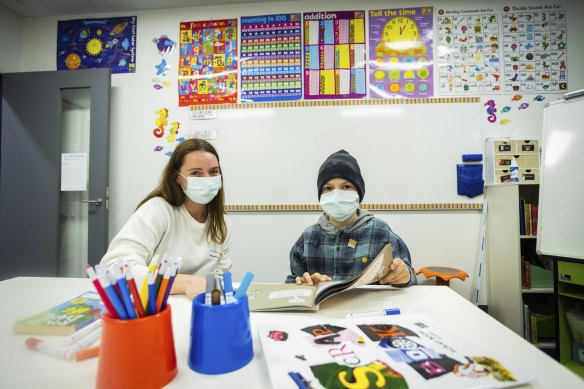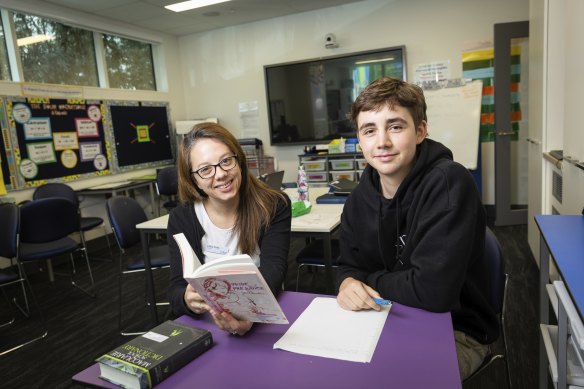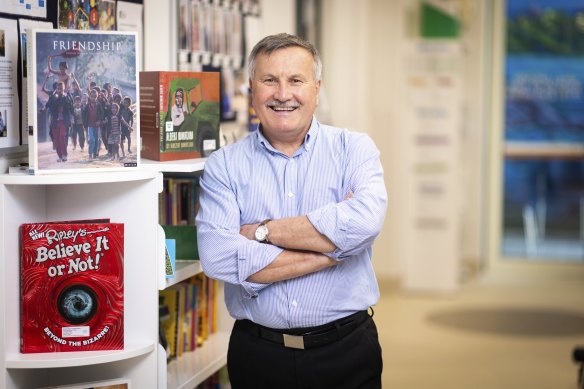The school inside a hospital, where teachers are ‘just as integral as the doctors’

Key points
- Hospital schools help students, both those staying in hospital and outpatients, who have chronic medical and/or mental health needs.
- Enrolments at Monash Children’s Hospital School are growing, at 1200 primary and secondary students this year.
- The students attend lessons for up to 3½ hours a day at their bedside or in small groups.
- The school will expand next year to help students attending Monash’s ADHD, paediatric refugee health and Healthy Koori Kid clinics.
Lana Formoso’s world crashed when her son Luka was diagnosed with leukaemia in April.
But Monash Children’s Hospital School emerged as a source of strength, providing Luka with one-on-one lessons during his treatment, sometimes at his bedside. It’s now helping Luka, 10, ease back into his regular school.
Monash Children’s Hospital School teacher Georgia Lay with student Luka, 10.Credit:Paul Jeffers
“We’re grateful to the oncology team for saving Luka’s life but what the school does is just as integral as what the doctors are doing,” Formoso said.
“I’m actually a teacher myself and had no idea that this hospital school even existed until I needed to. It’s changed our lives, and I’m sure it changes every single child’s life that comes here.”
There has been an increased focus on continuing the education of sick children over the past 15 years, particularly of students with mental health issues, cancer or eating disorders, who tend to miss long periods of school.
The Department of Education runs the school inside the hospital, following the lead of Westmead Hospital in Sydney and Queensland Children’s Hospital.
Monash Children’s Hospital School teacher Libby Petty with year 11 student Lewis.Credit:Paul Jeffers
The Monash school opened in 2018 to help children with serious medical health and mental health conditions – including acquired brain injuries, chronic fatigue and cystic fibrosis – continue their learning while undergoing treatment.
The pandemic and strict lockdowns were challenging for every school but especially so for ones with severely immuno-compromised students. Staff wore full PPE and there were visitor restrictions.
But remote learning was a silver lining, principal Colin Dobson said.
“A very positive thing that’s come out is young people with an ongoing chronic health condition, they felt greater connectivity in this time because they could have video classes, live classes and work that was up online,” Dobson said.
Monash Children’s Hospital School principal Colin Dobson.Credit:Paul Jeffers
The health conditions of their students also changed during COVID-19. Pauses in elective surgery led to fewer short-term students, and there were more young people living with an eating disorder.
Enrolments are growing. For the second year running, the hospital school will see 1200 primary and secondary students this year, or about 160 a week.
The students, who are hospital inpatients, outpatients or in recovery, attend lessons for up to 3½ hours a day at their bedside or in small groups.
Next year, the school will help students attending Monash’s ADHD, paediatric refugee health and Healthy Koori Kid clinics.
‘When you’re in a normal school you’re just one of 200 people, but the teachers [at the hospital school] go out of their way to help you individually. They work at your level.’
It’s a different sort of school and requires the 25-strong staff to work closely with not only students and families – who are sometimes at their most vulnerable – but their students’ regular schools and medical teams as well.
A typical day for teacher Georgia Lay starts with a medical handover, followed by a meeting with her oncology colleagues, lessons, writing notes, and meetings with her students’ schools and allied health staff.
Lay said she had wanted to work at a hospital school after watching some of her peers struggle with illness and education when she was a child.
She said the school provided a sense of normality and connectedness for students, and helped ease their transition back to regular school.
“We work on a lot of return-to-school plans and making sure that they are set up for success in their return, on a peer level and on an academic level,” she said.
Former student Lewis, 17, described his experience at the hospital school as comfortable.
“When you’re in a normal school you’re just one of 200 people, but the teachers [at the hospital school] go out of their way to help you individually. They work at your level,” the year 11 student said.
His teacher, Libby Petty, said the school built what looked like a regular weekly timetable but included different therapies, such as sessions with occupational therapists, psychologists, physiotherapists and social workers.
“We would ensure there were still rest breaks and times for meals so that the patient knows what they are doing, and they’ve also got a bit of a structure to their day because hospital can become very dull if you just sit in your room.”
Petty was motivated to work with students who would otherwise have gaps in their education.
“I’ve taught special ed, and I’ve taught many students who have had prolonged hospital stays, and the difference it makes them from having that continuity to having those gaps is extensive,” she said.
The Morning Edition newsletter is our guide to the day’s most important and interesting stories, analysis and insights. Sign up here.
Most Viewed in National
From our partners
Source: Read Full Article


